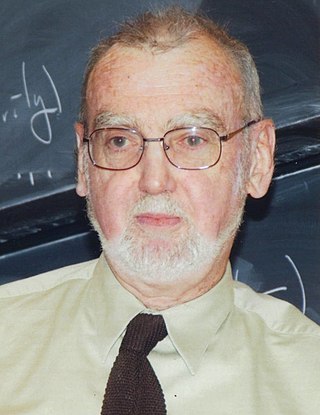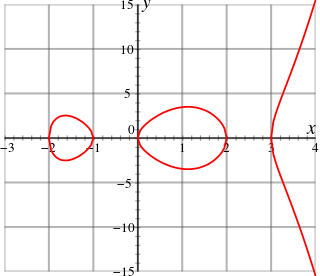Related Research Articles

Robert Phelan Langlands, is a Canadian mathematician. He is best known as the founder of the Langlands program, a vast web of conjectures and results connecting representation theory and automorphic forms to the study of Galois groups in number theory, for which he received the 2018 Abel Prize. He was an emeritus professor and occupied Albert Einstein's office at the Institute for Advanced Study in Princeton, until 2020 when he retired.
In representation theory and algebraic number theory, the Langlands program is a web of far-reaching and consequential conjectures about connections between number theory and geometry. Proposed by Robert Langlands, it seeks to relate Galois groups in algebraic number theory to automorphic forms and representation theory of algebraic groups over local fields and adeles. Widely seen as the single biggest project in modern mathematical research, the Langlands program has been described by Edward Frenkel as "a kind of grand unified theory of mathematics."
In mathematics, a Galois module is a G-module, with G being the Galois group of some extension of fields. The term Galois representation is frequently used when the G-module is a vector space over a field or a free module over a ring in representation theory, but can also be used as a synonym for G-module. The study of Galois modules for extensions of local or global fields and their group cohomology is an important tool in number theory.
In mathematics, the Sato–Tate conjecture is a statistical statement about the family of elliptic curves Ep obtained from an elliptic curve E over the rational numbers by reduction modulo almost all prime numbers p. Mikio Sato and John Tate independently posed the conjecture around 1960.
In mathematics, the Ramanujan conjecture, due to Srinivasa Ramanujan (1916, p. 176), states that Ramanujan's tau function given by the Fourier coefficients τ(n) of the cusp form Δ(z) of weight 12

In mathematics, arithmetic geometry is roughly the application of techniques from algebraic geometry to problems in number theory. Arithmetic geometry is centered around Diophantine geometry, the study of rational points of algebraic varieties.
In mathematics, an Artin L-function is a type of Dirichlet series associated to a linear representation ρ of a Galois group G. These functions were introduced in 1923 by Emil Artin, in connection with his research into class field theory. Their fundamental properties, in particular the Artin conjecture described below, have turned out to be resistant to easy proof. One of the aims of proposed non-abelian class field theory is to incorporate the complex-analytic nature of Artin L-functions into a larger framework, such as is provided by automorphic forms and the Langlands program. So far, only a small part of such a theory has been put on a firm basis.
In mathematics, a Drinfeld module is roughly a special kind of module over a ring of functions on a curve over a finite field, generalizing the Carlitz module. Loosely speaking, they provide a function field analogue of complex multiplication theory. A shtuka is a sort of generalization of a Drinfeld module, consisting roughly of a vector bundle over a curve, together with some extra structure identifying a "Frobenius twist" of the bundle with a "modification" of it.
In mathematics, a Weil group, introduced by Weil, is a modification of the absolute Galois group of a local or global field, used in class field theory. For such a field F, its Weil group is generally denoted WF. There also exists "finite level" modifications of the Galois groups: if E/F is a finite extension, then the relative Weil group of E/F is WE/F = WF/W c
E .
In representation theory, a branch of mathematics, the Langlands dualLG of a reductive algebraic group G is a group that controls the representation theory of G. If G is defined over a field k, then LG is an extension of the absolute Galois group of k by a complex Lie group. There is also a variation called the Weil form of the L-group, where the Galois group is replaced by a Weil group. Here, the letter L in the name also indicates the connection with the theory of L-functions, particularly the automorphic L-functions. The Langlands dual was introduced by Langlands (1967) in a letter to A. Weil.
In mathematics, the local Langlands conjectures, introduced by Robert Langlands, are part of the Langlands program. They describe a correspondence between the complex representations of a reductive algebraic group G over a local field F, and representations of the Langlands group of F into the L-group of G. This correspondence is not a bijection in general. The conjectures can be thought of as a generalization of local class field theory from abelian Galois groups to non-abelian Galois groups.
In number theory, a Shimura variety is a higher-dimensional analogue of a modular curve that arises as a quotient variety of a Hermitian symmetric space by a congruence subgroup of a reductive algebraic group defined over Q. Shimura varieties are not algebraic varieties but are families of algebraic varieties. Shimura curves are the one-dimensional Shimura varieties. Hilbert modular surfaces and Siegel modular varieties are among the best known classes of Shimura varieties.
In the mathematical theory of automorphic representations, a multiplicity-one theorem is a result about the representation theory of an adelic reductive algebraic group. The multiplicity in question is the number of times a given abstract group representation is realised in a certain space, of square-integrable functions, given in a concrete way.
In mathematics, the Langlands–Deligne local constant, also known as the local epsilon factor or local Artin root number, is an elementary function associated with a representation of the Weil group of a local field. The functional equation
In mathematics, the Langlands group is a conjectural group LF attached to each local or global field F, that satisfies properties similar to those of the Weil group. It was given that name by Robert Kottwitz. In Kottwitz's formulation, the Langlands group should be an extension of the Weil group by a compact group. When F is local archimedean, LF is the Weil group of F, when F is local non-archimedean, LF is the product of the Weil group of F with SU(2). When F is global, the existence of LF is still conjectural, though James Arthur gives a conjectural description of it. The Langlands correspondence for F is a "natural" correspondence between the irreducible n-dimensional complex representations of LF and, in the global case, the cuspidal automorphic representations of GLn(AF), where AF denotes the adeles of F.
In mathematics, Lafforgue's theorem, due to Laurent Lafforgue, completes the Langlands program for general linear groups over algebraic function fields, by giving a correspondence between automorphic forms on these groups and representations of Galois groups.
In mathematics, an automorphic L-function is a function L(s,π,r) of a complex variable s, associated to an automorphic representation π of a reductive group G over a global field and a finite-dimensional complex representation r of the Langlands dual group LG of G, generalizing the Dirichlet L-series of a Dirichlet character and the Mellin transform of a modular form. They were introduced by Langlands (1967, 1970, 1971).
In mathematics, the Taniyama group is a group that is an extension of the absolute Galois group of the rationals by the Serre group. It was introduced by Langlands (1977) using an observation by Deligne, and named after Yutaka Taniyama. It was intended to be the group scheme whose representations correspond to the (hypothetical) CM motives over the field Q of rational numbers.
Haruzo Hida is a Japanese mathematician, known for his research in number theory, algebraic geometry, and modular forms.
Laurent Clozel is a French mathematician and professor at Paris-Saclay University. His mathematical work is in the area of automorphic forms, including the Langlands program.
References
- Arthur, James; Clozel, Laurent (1989), Simple algebras, base change, and the advanced theory of the trace formula (PDF), Annals of Mathematics Studies, vol. 120, Princeton University Press, ISBN 978-0-691-08517-3, MR 1007299, archived from the original (PDF) on 2011-09-06
- Gelbart, Stephen (1977), "Automorphic forms and Artin's conjecture", Modular functions of one variable, VI (Proc. Second Internat. Conf., Univ. Bonn., Bonn, 1976), Lecture Notes in Math., vol. 627, Berlin, New York: Springer-Verlag, pp. 241–276, doi:10.1007/BFb0065304, ISBN 978-3-540-08530-0, MR 0568306
- Gérardin, Paul (1979), "Changement du corps de base pour les représentations de GL(2) [d'après R. P. Langlands, H. Saito, et T. Shintani]", Séminaire Bourbaki, 30e année (1977/78), Lecture Notes in Math., vol. 710, Berlin, New York: Springer-Verlag, pp. 65–88, doi:10.1007/BFb0069973, ISBN 978-3-540-09243-8, MR 0554215
- Gérardin, P.; Labesse, Jean-Pierre (1979), "The solution of a base change problem for GL(2) (following Langlands, Saito, Shintani)", in Borel, Armand; Casselman, W. (eds.), Automorphic forms, representations and L-functions (Proc. Sympos. Pure Math., Oregon State Univ., Corvallis, Ore., 1977), Part 2, Proc. Sympos. Pure Math., XXXIII, Providence, R.I.: American Mathematical Society, pp. 115–133, ISBN 978-0-8218-1435-2, MR 0546613
- Langlands, Robert P. (1980), Base change for GL(2), Annals of Mathematics Studies, vol. 96, Princeton University Press, ISBN 978-0-691-08263-9, MR 0574808
- Saito, Hiroshi (1975), Automorphic forms and algebraic extensions of number fields (PDF), Lectures in mathematics, vol. 8, Tokyo: Kinokuniya Book-Store Co. Ltd., MR 0406936
- Saito, Hiroshi (1975b), "Automorphic forms and algebraic extensions of number fields", Proceedings of the Japan Academy, 51 (4): 229–233, doi: 10.3792/pja/1195518624 , hdl: 2433/84913 , ISSN 0021-4280, MR 0384703
- Saito, Hiroshi (1979), "Automorphic forms and algebraic extensions of number fields. II", Journal of Mathematics of Kyoto University, 19 (1): 105–123, ISSN 0023-608X, MR 0527398
- Shintani, Takuro (1979), "On liftings of holomorphic cusp forms" (PDF), in Borel, Armand; Casselman, W. (eds.), Automorphic forms, representations and L-functions (Proc. Sympos. Pure Math., Oregon State Univ., Corvallis, Ore., 1977), Part 2, Proc. Sympos. Pure Math., XXXIII, Providence, R.I.: American Mathematical Society, pp. 97–110, ISBN 978-0-8218-1437-6, MR 0546611